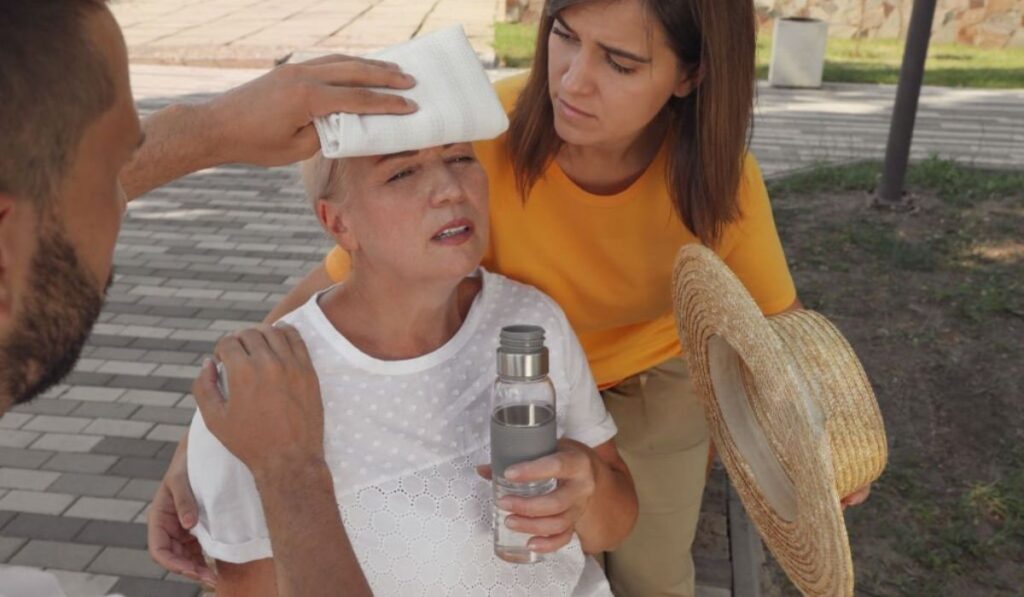In summer, when you sweat a lot, there is a great risk of two things happening—first, electrolyte imbalance. When you sweat, your body loses salts. Sodium is lost, chloride is lost, and many salts are lost in sweat. Along with this, there is a great risk of heat stroke, which is very damaging. And when you sweat a lot, the risk of two things increases a lot—first, electrolyte imbalance. When you sweat, salts are also lost along with sweat. And second, heat stroke. Heat stroke comes after an electrolyte imbalance.
First, you sweat a lot. When it is hot, your body produces sweat to cool down a little. And when you sweat, water is lost from the body. So along with this, salts are also being lost from your body, and if you do not take yourself to a shady place and do not rest, and you are continuously sweating and you are continuously in the heat and sunlight, then there are high chances that you may get heat stroke. Heat stroke means that your body is not able to maintain its temperature.
You people know that your body temperature is fixed at 37.5 degrees Celsius. It has to maintain this temperature, whether it is cold or hot outside. It has to maintain this temperature. If it is very hot outside, your body temperature will start to increase, it will start to go above 37, and when it tries to go up, the body produces sweat to reduce the temperature, and the blood vessels swell and dilate.
That is why you must have seen that in summer, the blood vessels on your upper arm are a little more visible because the blood vessels dilate to allow more heat to escape. But if you stand in extreme heat for too long or are doing any work, your body becomes tired, and it is no longer able to dissipate the heat. When it is not able to dissipate the heat, your body temperature will start to rise. When the body temperature rises, this is what causes heat stroke.
What are the symptoms of heat stroke?
In heat stroke, the first thing you start to feel is muscle cramps because your body is sweating and at the same time, salts are being lost. Due to the loss of salts, your muscles start to ache, and it feels as if they have started to swell. At the same time, you start to get a headache, and it is such a headache that you feel that your blood vessels are bursting, and then you feel extremely tired.
You feel like someone has beaten you and thrown you. If you still do not recognize heat stroke, then in the later stages, you start to get confused. Now you are confused. You do not understand what is happening back and forth, and then you cannot speak. Your speech becomes slurred. Sometimes you start to have tremors because there is an electrolyte imbalance in your body. You become dehydrated, and then eventually you become unconscious, and even then, if someone doesn’t take you out of the heat and into a shady place, there’s a good chance that you’ll die.
How to avoid this heat stroke and electron light imbalance?
For electrolyte imbalance, whenever your body sweats and loses salts, you have to replenish these salts. If you use plain water to replenish these salts, it can improve you to some extent. But the best way is to use water that also contains salts.
Now, what kind of water can that be?
By the way, the support drinks available contain salts, meaning they are suitable for athletes and people who play outside on the grounds. They know that they will sweat and lose their salts, and therefore, the salts that are already present in them are the ones that are lost from their body in the form of sweat. But not everyone can afford a support drink.
What kind of heat is there on any one day?
It has to be hot every day. Therefore, apart from a support drink, you should not drink any such drink. You can use water with a little salt added to it, like sikandjiban, which is a great way to improve your electrolyte imbalance. I am saying this because when you sweat, sodium is lost from your body. Chloride is lost from your body.
These are the same things that are present in salt. Sodium and chloride are the only things that are present in salt. But the problem here is that people who are suffering from any disease, like high blood pressure or diabetes, can have their blood pressure increase further if they consume too much salt. Therefore, you should not consume too much salt and keep yourself well hydrated. This means drinking water little by little. If you are out in the heat, then you should keep drinking water little by little.
If someone has heat stroke, what can you do?
First of all, if you are showing these symptoms yourself, you have started to get confused or your muscles have started to cramp, and fatigue has started to increase, then immediately go to a shady place, take a break for a while, and drink water so that your body temperature decreases a little. And if someone has fainted, then immediately take them to a shady place, spray a little water on their body or take a wet cloth and wrap it over their body and at the same time, be sure to call for help because it may be that after they have fainted, they may come back to consciousness or not.

You don’t know, so immediately call for help so that someone can take them to the hospital, and at the same time, you can reduce their body temperature a little, like a fan, if you can. If you have a fan nearby, or you can blow on it with anything so that the air reaches its body and the temperature is a little lower, and if it is conscious, give it water to drink. Now,
How can heatstroke be avoided?
The best way is to stay out of the sun when it is very hot. Children and the elderly are the two categories that are most affected by heatstroke. When the heat is very high, it is not necessary to go out at this time. If you must go out, keep water with you and take frequent breaks. After a while, stop under a shady tree or in a shady place where there is water. Apart from this, your clothes should be loose; do not wear tight-fitting clothes. The color of the clothes should be light. The darker the color, the more sunlight it attracts and the more the temperature increases. That is why people wear light-colored clothes in summer.
Conclusion
Preventing a life-threatening stroke starts with making smart, consistent lifestyle choices. Managing blood pressure, maintaining a healthy diet, staying physically active, avoiding smoking and excessive alcohol, and controlling conditions like diabetes and high cholesterol can significantly reduce your stroke risk. Regular medical checkups and knowing the warning signs—like sudden numbness, confusion, trouble speaking, or vision problems—can also lead to early intervention and better outcomes. Ultimately, stroke prevention is in your hands. Stay informed, stay proactive, and prioritize your health every day.

